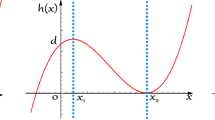Abstract
In this paper, we consider a two-predator–one-prey population model that incorporates both the inter-specific competition between two predator populations and the intra-specific competition within each predator population. We investigate the dynamics of this model by addressing the existence, local and global stability of equilibria, uniform persistence as well as saddle-node and Hopf bifurcations. Numerical simulations are presented to explore the joint impacts of inter-specific and intra-specific competition on competition outcomes. Though inter-specific competition along does not admit a stable coexistence equilibrium, with intra-specific competition, the coexistence of the two competing predator species becomes possible and the two coexisting predator species may maintain at two different equilibrium populations.










Similar content being viewed by others
References
Lotka, A.J.: Elements of Physical Biology. Williams and Wilkins, Baltimore (1925)
Volterra, V.: Variazionie fluttuazioni del numero d’individui in specie animali conviventi. Mem. Acad. Lincei. 2, 31–113 (1925) (Variations and fluctuations of a number of individuals in animal species living together. Translation In: R.N. Chapman: Animal Ecology. New York: McGraw Hill 1931, pp. 409–448)
Turchin, P.: Complex Population Dynamics: A Theoretical/Empirical Synthesis. Princeton University Press, Princeton (2003)
Holling, C.S.: The functional response of predator to prey density and its role in mimicry and population regulations. Mem. Entomol. Soc. Can. 45, 5–60 (1965)
Beddington, J.R.: Mutual interference between parasites or predators and its effect on searching efficiency. J. Anim. Ecol. 44, 331–340 (1975)
DeAngelis, D.L., Goldstein, R.A., O’Neill, R.V.: A model for trophic interaction. Ecology 56, 881–892 (1975)
Real, L.: The kinetics of functional response. Am. Nat. 111, 289–300 (1977)
Ding, W., Huang, W.: Global dynamics of a predator–prey model with general Holling type functional responses. J. Dyn. Differ. Equ. 32, 965–978 (2020)
May, R.M., Leonard, W.J.: Nonlinear aspects of competition between three species. SIAM J. Appl. Math. 29, 243–253 (1975)
Caswell, H.: Predator-mediated coexistence: a nonequilibrium model. Am. Nat. 112, 127–154 (1978)
Hutson, V., Law, R.: Permanent coexistence in general models of three interacting species. J. Math. Biol. 44, 285–298 (1985)
Hsu, S.B., Hwang, T.W.: Global stability for a class of predator–prey systems. SIAM J. Appl. Math. 55, 763–783 (1995)
May, R.M.: Stability and Complexity in Ecosystems. Princeton University Press, Princeton (2001)
Xia, Y., Han, M.: New conditions on the existence and stability of periodic solution in a Lokta–Volterra’s population system. SIAM J. Appl. Math. 69, 1580–1597 (2009)
Mishra, P., Raw, S.N.: Dynamical complexities in a predator–prey system involving teams of two prey and one predator. J. Appl. Math. Comput. 61, 1–24 (2019)
Freedman, H.I., Waltman, P.: Persistence in models of three interacting predator–prey populations. Math. Biosci. 68, 213–231 (1984)
Gakkhar, S., Singh, B., Naji, R.K.: Dynamical behavior of two predators competing over a single prey. Biosystems 90, 808–817 (2007)
Dubey, B., Upadhyay, R.K.: Persistence and extinction of one-prey and two-predators system. Nonlinear Anal. Model. Control 9, 307–329 (2004)
Alebraheem, J., Abu-Hasan, Y.: Persistence of predators in a two predators-one prey model with non-periodic solution. Appl. Math. Sci. 6, 943–956 (2012)
Hanski, I., Hansson, L., Henttonen, H.: Specialist predators, generalist predators, and the microtine rodent cycle. J. Anim. Ecol. 60, 353–367 (1991)
Pielou, E.C.: An Introduction to Mathematical Ecology. Wiley, New York (1970)
Haque, M., Ali, N., Chakravarty, S.: Study of a tri-trophic prey-dependent food chain model of interacting populations. Math. Biosci. 246, 55–71 (2013)
LaSalle, J..P.: The Stability of Dynamical Systems. Regional Conference Series in Applied Mathematics. SIAM, Philadelphia (1976)
Hutson, V.: A theorem on average Liapunov functions. Mh. Math. 98, 267–275 (1984)
Strogatz, S.H.: Nonlinear Dynamics and Chaos: With Applications to Physics, Biology, Chemistry, and Engineering, 2nd edn. CRC Press, New York (2019)
Hutson, V.: The existence of an equilibrium for permanent systems. Rocky Mt. J. Math. 20, 1033–1040 (1990)
Zhao, X.-Q.: Dynamical Systems in Population Biology, 2nd edn. Springer, New York (2017)
Sarwardi, S., Mandal, P.K., Ray, S.: Dynamical behaviour of a two-predator model with prey refuge. J. Biol. Phys. 39, 701–722 (2013)
Hardin, G.: The competitive exclusion principle. Science 131, 1292–1297 (1960)
Acknowledgements
The authors are very grateful to the reviewers’ comments and suggestions. This work was partially supported by Guangdong Science and Technology Department (No. 2020A1414010119), and National Natural Science Foundation of China (No. 12071095) and NSERC of Canada. Part of the work was carried out when YL was visiting the University of New Brunswick (UNB). YL wishes to thank the hospitality received from UNB. YL also would like to thank Prof. Zhiming Guo of Guangzhou University for very helpful discussions.
Author information
Authors and Affiliations
Corresponding author
Additional information
Publisher's Note
Springer Nature remains neutral with regard to jurisdictional claims in published maps and institutional affiliations.
Rights and permissions
About this article
Cite this article
Long, Y., Wang, L. & Li, J. Uniform persistence and multistability in a two-predator–one-prey system with inter-specific and intra-specific competition. J. Appl. Math. Comput. 68, 767–794 (2022). https://doi.org/10.1007/s12190-021-01551-8
Received:
Revised:
Accepted:
Published:
Issue Date:
DOI: https://doi.org/10.1007/s12190-021-01551-8




